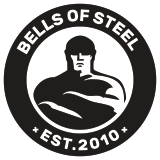Whether you’re just starting to build your own home gym or you’re looking to expand your existing setup, picking the right equipment is essential.
But, should you go for a set of squat stands or splurge on a full power rack?
The truth is, knowing what YOU value most in your home gym is critical to making the right choice.
In this article, we’ve compiled the key factors you should consider when comparing a squat stand vs power rack, so that you don’t regret your decision later on.
Let’s dive in!
What is a squat stand?
A squat stand is two uprights (pieces of vertical steel tubing) that are welded to a base.
Sometimes, the two uprights are welded to the same base but they can also be completely independent of one another.
In some cases, they can even have a pull-up bar. Although, that tends to move it into the “half power rack” category instead of being considered a squat stand.
In all cases though, the lifter trains in front of the unit rather than inside it like a power rack because there are only two uprights.
What is a power rack?
A power rack — also known as a power cage, squat cage, or squat rack — has four vertical steel uprights in a rectangular or square formation.
Typically, the lifter works out inside the rack, using a pair of j-cups for racking the bar and some form of safety pins or straps for catching the bar if a rep is failed.
Power racks also have at least one straight pull-up/chin-up bar or an upgraded multi-grip bar for extra grip options.
What’s the difference between a squat stand vs power rack?
When comparing a squat stand vs a power rack, there are five main differences to consider:
Cost
Sometimes, a thinner gauge of steel is also used. When factoring in both of these, squat stands are hundreds of dollars cheaper than even a budget-friendly power rack.
Squat stands are the more affordable unit, as they’re made with significantly less steel than a power rack.
On the other hand, a power rack is built with much more steel. The four uprights, side beams and cross beams — along with a thicker gauge of steel being used — make it much more expensive.
Space Required
Usually, each stand is about 2-3’ in length and 2-3’ in width with some having built-in wheels.
Squat stands are designed specifically to be smaller and more portable than a power rack.
This means that they’re not only more compact for space-constrained lifters, they’re easily portable and can be tucked away when not in use.
On the contrary, power racks tend to be permanent structures that occupy an absolute minimum of 3’ x 4’ of floor space.
They’re often bolted down into a lifting platform or a concrete floor. So, good luck trying to tuck it away after every workout.
Exercise Versatility
The large, heavy steel frame of a power rack gives it a great foundation for mounting rack attachments to add dozens of exercises.
There’s no question that squat stands lack exercise versatility when measured up to a power rack.
Whether it’s a landmine, dip bars or a set of lever arms, these attachments simply can’t be safely used with squat stands — they’re just not stable enough to safely allow it.
Safety
Since there is only one upright per side, safety straps, drop-in safeties, and the classic pin and pipe safety system are not an option with squat stands.
And while spotter arms are often compatible with them, many squat stands will actually tip over if a barbell is rested on them — so we do NOT recommend you go this route with your squat stands.
Click here to Check out our video where we test our squat stands with our spotter arms.
A power rack is the clear winner when it comes to safety. The thicker steel, heavier weight and larger footprint creates a much more stable unit.
With safety pins or safety straps able to be placed at dozens of heights, you’ll be able to workout and train to failure safely.
Storage Options
Finally, a power rack can have an additional row of uprights towards the rear of the cage like our full-sized Brute Rack.
These two additional uprights are there as a place to store weight plates and other accessories like bands, chains, belts, and so forth.
Due to the slim and lightweight design of squat stands, they lack any plate storage ability. Unless you have a weight plate tree, you’ll be stuck with storing your plates on the floor.
Squat Stand vs Power Rack: Is one better than the other?
Technically, no. While both power racks and squat stands allow you to squat, overhead press, and bench press, they do each have their own benefits as well as drawbacks.
A power rack is more versatile and more stable. There are more accessory options for rack attachments and convenient storage for plates.
That said, squat stands take up less space. They’re also easy to move around the gym; especially handy if you’re training in a garage and need to make room for a vehicle at the end of the day.
They also cost significantly less money, too.
So if you want to dip, kip, rack pull, have somewhere to store plates, and add major accessories like the cable crossover and lever arms, you’ll be better off with a power rack.
It’s hard to put a price on safety, too.
If all you care about is somewhere to rack your bar for squats and overhead presses though, a squat stand would serve you well and save you quite a bit of coin.
Bells of Steel USA Contact
Bells of Steel USA Showroom
6002 Corporate Way,
Indianapolis, IN 46278,
United States
Phone: 1 317-981-5586








